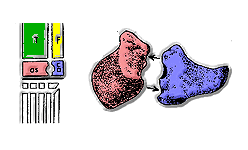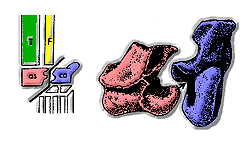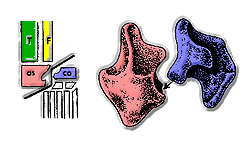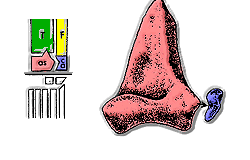Archosaur
| Archosaurs | |||
|---|---|---|---|
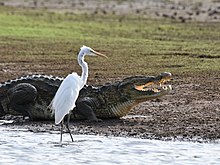
| |||
| Birds and crocodilians (in this case, agreat egretand amugger crocodile) are the only living archosaur groups. | |||
| Scientific classification | |||
| Domain: | Eukaryota | ||
| Kingdom: | Animalia | ||
| Phylum: | Chordata | ||
| Class: | Reptilia | ||
| Clade: | Archosauromorpha | ||
| Clade: | Archosauriformes | ||
| Clade: | Eucrocopoda | ||
| Clade: | Archosauria Cope,1869 | ||
| Subgroups | |||
| |||
| Synonyms | |||
| |||
Archosauria(lit. 'ruling reptiles') orarchosaurs(/ˈɑːrkəˌsɔːr/[3]) is acladeofdiapsidsauropsidtetrapods,withbirdsandcrocodiliansbeing the onlyextantrepresentatives. Although broadly classified asreptiles,which traditionally exclude birds, thecladisticsense of the term includes all living andextinctrelatives of birds and crocodilians such asnon-avian dinosaurs,pterosaurs,phytosaurs,aetosaursandrauisuchiansas well as manyMesozoic marine reptiles.Modern paleontologists define Archosauria as acrown groupthat includes themost recent common ancestorof living birds and crocodilians, and all of its descendants.
The base of Archosauria splits into two clades:Pseudosuchia,which includes crocodilians and their extinct relatives; andAvemetatarsalia,which includes birds and their extinct relatives (such as non-avian dinosaurs and pterosaurs).[4]Older definitions of the group Archosauria rely on sharedmorphologicalcharacteristics, such as anantorbital fenestrain the skull,serratedteeth, and an upright stance. Some extinct reptiles, such asproterosuchidsandeuparkeriids,also possessed these features yet originated prior to the split between the crocodilian and bird lineages. The older morphological definition of Archosauria nowadays roughly corresponds toArchosauriformes,a group named to encompass crown-group archosaurs and their close relatives.[4]
The oldest true archosaurfossilsare known from theEarly Triassicperiod, though the firstarchosauriformsandarchosauromorphs(reptilians closer to archosaurs than tolizardsor otherlepidosaurs) appeared in thePermian.Archosaurs quickly diversified in the aftermath of thePermian-Triassic mass extinction(~252Ma), which wiped out most of the then-dominanttherapsidcompetitors such as thegorgonopsiansandanomodonts,and the subsequent arid Triassic climate allowed the moredrought-resiliant archosaurs (largely due to theiruric acid-basedurinary system) to eventually become the largest and most ecologically dominant terrestrial vertebrates from theMiddle Triassicperiod up until theCretaceous–Paleogene extinction event(~66 Ma).[5]Birds and severalcrocodyliformlineages were the only archosaurs to survive theK-Pgextinction, rediversifying in the subsequentCenozoicera. Birds in particular have become among the most species-rich groups of terrestrial vertebrates in the present day.
Distinguishing characteristics
[edit]Archosaurs can traditionally be distinguished from other tetrapods on the basis of severalsynapomorphies,or shared characteristics, which were present in theirlast common ancestor.Many of these characteristics appeared prior to the origin of the clade Archosauria, as they were present inarchosauriformssuch asProterosuchusandEuparkeria,which were outside thecrown group.[4]
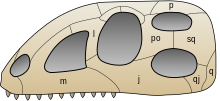
The most obvious features include teeth set in deep sockets,antorbitalandmandibular fenestrae(openings in front of the eyes and in the jaw, respectively),[6]and a pronouncedfourth trochanter(a prominent ridge on thefemur).[7]Being set in sockets, the teeth were less likely to be torn loose during feeding. This feature is responsible for the name "thecodont"(meaning" socket teeth "),[8]which early paleontologists applied to many Triassic archosaurs.[7]Additionally, non-muscular cheek and lip tissue appear in various forms throughout the clade, with all living archosaurs lacking non-muscular lips, unlike mostnon-aviansaurischiandinosaurs.[9]Some archosaurs, such as birds, are secondarily toothless. Antorbital fenestrae reduced the weight of the skull, which was relatively large in early archosaurs, rather like that of moderncrocodilians.Mandibular fenestrae may also have reduced the weight of the jaw in some forms. The fourth trochanter provides a large site for the attachment of muscles on the femur. Stronger muscles allowed for erect gaits in early archosaurs, and may also be connected with the ability of the archosaurs or their immediate ancestors to survive the catastrophicPermian-Triassic extinction event.[citation needed]
Unlike their close living relatives, the lepidosaurs, archosaurs lost thevomeronasal organ.[10]
Origins
[edit]Archosaurs are a subgroup ofarchosauriforms,which themselves are a subgroup ofarchosauromorphs.Both the oldest archosauromorph (Protorosaurus speneri) and the oldest archosauriform (Archosaurus rossicus) lived in the late Permian. The oldest true archosaurs appeared during theOlenekianstage (247–251 Ma) of theEarly Triassic.A few fragmentary fossils of large carnivorous crocodilian-line archosaurs (informally termed "rauisuchians") are known from this stage. These includeScythosuchusandTsylmosuchus(both of which have been found inRussia),[11]as well as theXilousuchus,actenosauriscidfromChina.[4]The oldest known fossils of bird-line archosaurs are from theAnisianstage (247–242 Ma) ofTanzania,and includeAsilisaurus(an earlysilesaurid),Teleocrater(anaphanosaur), andNyasasaurus(a possible early dinosaur).[citation needed]
Archosaurian domination in the Triassic
[edit]Synapsidsare a clade that includesmammalsandtheir extinct ancestors.The latter group are often referred to asmammal-like reptiles,but should be termedprotomammals, stem mammals, or basal synapsids,because they are not true reptiles by moderncladisticclassification. They were the dominant land vertebrates throughout thePermian,but most perished in thePermian–Triassic extinction event.Very few large synapsids survived the event, but one form,Lystrosaurus(aherbivorousdicynodont), attained a widespread distribution soon after the extinction.[12]Following this, archosaurs and other archosauriforms quickly became the dominant land vertebrates in the earlyTriassic.Fossils from before the mass extinction have only been found around the Equator, but after the event fossils can be found all over the world.[13]Suggested explanations for this include:
- Archosaurs made more rapid progress towards erect limbs than synapsids, and this gave them greater stamina by avoidingCarrier's constraint.An objection to this explanation is that archosaurs became dominant while they still had sprawling or semi-erect limbs, similar to those ofLystrosaurusand other synapsids.[citation needed]
- Archosaurs have more efficient[clarification needed]respiratory systems featuring unidirectional air flow, as opposed to the tidal respiration of synapids.[14]The ability to breathe more efficiently inhypoxicconditions may have been advantageous to early archosaurs during the suspected drop in oxygen levels at the end of the Permian.[14]
- TheEarly Triassicwas predominantly arid, because most of theEarth's land was concentrated in thesupercontinentPangaea.Archosaurs were probably better at conserving water than early synapsids because:
- Moderndiapsids(lizards, snakes, crocodilians, birds) excreteuric acid,which can be excreted as a paste, resulting in low water loss as opposed to a more dilute urine. It is reasonable to suppose that archosaurs (the ancestors of crocodilians, dinosaurs and pterosaurs) also excreted uric acid, and therefore were good at conserving water. The aglandular (glandless) skins of diapsids would also have helped to conserve water.[citation needed]
- Modern mammals excreteurea,which requires a relatively high urinary rate to keep it from leaving the urine by diffusion in the kidney tubules. Their skins also contain many glands, which also lose water. Assuming that early synapsids had similar features, e.g., as argued by the authors ofPalaeos,they were at a disadvantage in a mainly arid world. The same well-respected site points out that "for much of Australia'sPlio-Pleistocenehistory, where conditions were probably similar, the largest terrestrial predators were not mammals but giganticvaranidlizards (Megalania) and land crocs. "[8]
However, this theory has been questioned, since it implies synapsids were necessarily less advantaged in water retention, that synapsid decline coincides with climate changes or archosaur diversity (neither of which tested) and the fact that desert dwelling mammals are as well adapted in this department as archosaurs,[15]and some cynodonts likeTrucidocynodonwere large sized predators.[16] A study favors competition amidst mammaliaforms as the main explanation for Mesozoic mammals being small.[17]
Main forms
[edit]
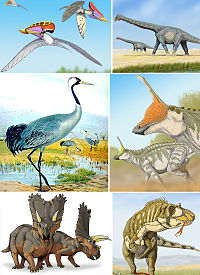
Since the 1970s, scientists have classified archosaurs mainly on the basis of their ankles.[18]The earliest archosaurs had "primitive mesotarsal" ankles: theastragalusandcalcaneumwere fixed to thetibiaandfibulabysuturesand the joint bent about the contact between these bones and the foot.
ThePseudosuchiaappeared early in theTriassic.In their ankles, the astragalus was joined to the tibia by asutureand the joint rotated round a peg on the astragalus which fitted into a socket in the calcaneum. Early "crurotarsans" still walked with sprawling limbs, but some later crurotarsans developed fully erect limbs. Modern crocodilians are crurotarsans that can employ a diverse range of gaits depending on speed.[19]
Euparkeriaand theOrnithosuchidaehad "reversed crurotarsal" ankles, with a peg on the calcaneum and socket on the astragalus.
The earliest fossils ofAvemetatarsalia( "bird ankles" ) appear in theAnisianage of theMiddle Triassic.Most Ornithodirans had "advanced mesotarsal" ankles. This form of ankle incorporated a very large astragalus and very small calcaneum, and could only move in one plane, like a simple hinge. This arrangement, which was only suitable for animals with erect limbs, provided more stability when the animals were running. The earliest avemetatarsalians, such as Teleocrater and Asilisaurus, retained "primitive mesotarsal" ankles. The ornithodirans differed from other archosaurs in other ways: they were lightly built and usually small, their necks were long and had an S-shaped curve, their skulls were much more lightly built, and many ornithodirans were completelybipedal.The archosaurian fourth trochanter on the femur may have made it easier for ornithodirans to become bipeds, because it provided more leverage for the thigh muscles. In the late Triassic, the ornithodirans diversified to producedinosaursandpterosaurs.
Classification
[edit]Modern classification
[edit]Archosauria is normally defined as acrown group,which means that it only includes descendants of the last common ancestors of its living representatives. In the case of archosaurs, these are birds and crocodilians. Archosauria is within the larger cladeArchosauriformes,which includes some close relatives of archosaurs, such asproterochampsidsandeuparkeriids.These relatives are often referred to as archosaurs despite being placed outside of the crown group Archosauria in a morebasalposition within Archosauriformes.[20]Historically, many archosauriforms were described as archosaurs, includingproterosuchidsanderythrosuchids,based on the presence of an antorbital fenestra. While many researchers prefer to treat Archosauria as an unrankedclade,some continue to assign it a traditional biological rank. Traditionally, Archosauria has been treated as a Superorder, though a few 21st century researchers have assigned it to different ranks including Division[21]and Class.[22]
History of classification
[edit]Archosauria as a term was first coined by American paleontologistEdward Drinker Copein 1869, and included a wide range of taxa includingdinosaurs,crocodilians,thecodonts,sauropterygians(which may be related to turtles),rhynchocephalians(a group that according to Cope includedrhynchosaurs,which nowadays are considered to be more basalarchosauromorphs,andtuataras,which arelepidosaurs), andanomodonts,which are now considered synapsids.[23]It was not until 1986 that Archosauria was defined as a crown-clade, restricting its use to morederivedtaxa.[24]
Cope's term was a Greek-Latinhybridintended to refer to the cranial arches, but has later also been understood as "leading reptiles" or "ruling reptiles" by association with Greekἀρχός"leader, ruler".[25]
The term "thecodont", now considered an obsolete term, was first used by the English paleontologistRichard Owenin 1859 to describe Triassic archosaurs, and it became widely used in the 20th century. Thecodonts were considered the "basal stock" from which the more advanced archosaurs descended. They did not possess features seen in later avian and crocodilian lines, and therefore were considered more primitive and ancestral to the two groups. With thecladistic revolutionof the 1980s and 90s, in whichcladisticsbecame the most widely used method of classifying organisms, thecodonts were no longer considered a valid grouping. Because they are considered a "basal stock", thecodonts areparaphyletic,meaning that they form a group that does not include all descendants of its last common ancestor: in this case, the more derived crocodilians and birds are excluded from "Thecodontia" as it was formerly understood. The description of the basalornithodiresLagerpetonandLagosuchusin the 1970s provided evidence that linked thecodonts with dinosaurs, and contributed to the disuse of the term "Thecodontia", which many cladists consider an artificial grouping.[26]
With the identification of "crocodilian normal" and "crocodilian reversed" ankles bySankar Chatterjeein 1978, a basal split in Archosauria was identified. Chatterjee considered these two groups to be Pseudosuchia with the "normal" ankle and Ornithosuchidae with the "reversed" ankle. Ornithosuchids were thought to be ancestral to dinosaurs at this time. In 1979,A.R.I. Cruickshankidentified the basal split and thought that the crurotarsan ankle developed independently in these two groups, but in opposite ways. Cruickshank also thought that the development of these ankle types progressed in each group to allow advanced members to have semi-erect (in the case of crocodilians) or erect (in the case of dinosaurs) gaits.[26]
Phylogeny
[edit]In manyphylogeneticanalyses, archosaurs have been shown to be amonophyleticgrouping, thus forming a true clade. One of the first studies of archosaur phylogeny was authored by French paleontologistJacques Gauthierin 1986. Gauthier split Archosauria intoPseudosuchia,the crocodilian line, andOrnithosuchia,the dinosaur and pterosaur line. Pseudosuchia was defined as all archosaurs more closely related to crocodiles, while Ornithosuchia was defined as all archosaurs more closely related to birds. Proterochampsids, erythrosuchids, and proterosuchids fell successively outside Archosauria in the resulting tree. Below is thecladogramfrom Gauthier (1986):[27]
In 1988, paleontologistsMichael Bentonand J. M. Clark produced a new tree in a phylogenetic study of basal archosaurs. As in Gauthier's tree, Benton and Clark's revealed a basal split within Archosauria. They referred to the two groups as Crocodylotarsi and Ornithosuchia. Crocodylotarsi was defined as anapomorphy-based taxon based on the presence of a "crocodile-normal" ankle joint (considered to be the defining apomorphy of the clade). Gauthier's Pseudosuchia, by contrast, was astem-based taxon.Unlike Gauthier's tree, Benton and Clark's placesEuparkeriaoutside Ornithosuchia and outside the crown group Archosauria altogether.[28]
The clades Crurotarsi and Ornithodira were first used together in 1990 by paleontologistPaul Serenoand A. B. Arcucci in their phylogenetic study of archosaurs. They were the first to erect the clade Crurotarsi, while Ornithodira was named by Gauthier in 1986. Crurotarsi and Ornithodira replaced Pseudosuchia and Ornithosuchia, respectively, as the monophyly of both of these clades were questioned.[26][29]Sereno and Arcucci incorporated archosaur features other than ankle types in their analyses, which resulted in a different tree than previous analyses. Below is a cladogram based on Sereno (1991), which is similar to the one produced by Sereno and Arcucci:[26]
Ornithodira and Crurotarsi are bothnode-basedclades, meaning that they are defined to include thelast common ancestorof two or more taxa and all of its descendants. Ornithodira includes the last common ancestor of pterosaurs and dinosaurs (which include birds), while Crurotarsi includes the last common ancestor of living crocodilians and three groups of Triassic archosaurs:ornithosuchids,aetosaurs,andphytosaurs.These clades are not equivalent to "bird-line" and "crocodile-line" archosaurs, which would bebranch-basedclades defined as all taxa more closely related to one living group (either birds or crocodiles) than the other.
Benton proposed the name Avemetatarsalia in 1999 to include all bird-line archosaurs (under his definition, all archosaurs more closely related to dinosaurs than to crocodilians). His analysis of the small Triassic archosaurScleromochlusplaced it within bird-line archosaurs but outside Ornithodira, meaning that Ornithodira was no longer equivalent to bird-line archosaurs. Below is a cladogram modified from Benton (2004) showing this phylogeny:[24]
| Archosauria |
| ||||||||||||||||||||||||||||||
InSterling Nesbitt's 2011 monograph on early archosaurs, a phylogenetic analysis found strong support for phytosaurs falling outside Archosauria. Many subsequent studies supported this phylogeny. Because Crurotarsi is defined by the inclusion of phytosaurs, the placement of phytosaurs outside Archosauria means that Crurotarsi must include all of Archosauria. Nesbitt reinstated Pseudosuchia as a clade name for crocodile-line archosaurs, using it as a stem-based taxon. Below is a cladogram modified from Nesbitt (2011):[4]
| Sauropsida |
| ||||||
Extinction and survival
[edit]Crocodylomorphs, pterosaurs and dinosaurs survived theTriassic–Jurassic extinction eventabout 200 million years ago, but other archosaurs had become extinct at or prior to the Triassic-Jurassic boundary.
Non-avian dinosaurs andpterosaursperished in theCretaceous–Paleogene extinction event,which occurred approximately 66 million years ago, butcrown-groupbirds (the only remaining dinosaur group) and many crocodyliforms survived. Both are descendants of archosaurs, and are therefore archosaurs themselves underphylogenetic taxonomy.
Crocodilians (which include all moderncrocodiles,alligators,andgharials) and birds flourish today in theHolocene.It is generally agreed that birds have the most species of all terrestrial vertebrates.[citation needed]
Archosaur lifestyle
[edit]Hip joints and locomotion
[edit]
Like the earlytetrapods,early archosaurs had a sprawling gait because their hip sockets faced sideways, and the knobs at the tops of theirfemurswere in line with the femur. In the early to middleTriassic,some archosaur groups developed hip joints that allowed (or required) a more erect gait. This gave them greater stamina, because it avoidedCarrier's constraint,i.e. they could run and breathe easily at the same time. There were two main types of joint which allowed erect legs:
- The hip sockets faced sideways, but the knobs on the femurs were at right angles to the rest of the femur, which therefore pointed downwards. Dinosaurs evolved from archosaurs with this hip arrangement.
- The hip sockets faced downwards and the knobs on the femurs were in line with the femur. This "pillar-erect" arrangement appears to have evolved independently in various archosaur lineages, for example it was common in "Rauisuchia" (non-crocodylomorphparacrocodylomorphs) and also appeared in someaetosaurs.
It has been pointed out that an upright stance requires more energy, so it may indicate a higher metabolism and a higher body temperature.[30]
Diet
[edit]Most were large predators, but members of various lines diversified into other niches.Aetosaurswere herbivores and some developed extensive armor. A few crocodyliforms were herbivores, e.g.,Simosuchus,Phyllodontosuchus.The large crocodyliformStomatosuchusmay have been afilter feeder.Sauropodomorphsandornithischiandinosaurs were herbivores with diverse adaptations for feedingbiomechanics.
Land, water and air
[edit]Archosaurs are mainly portrayed aslandanimals, but:
- Many phytosaurs and crocodyliforms dominated the rivers and swamps and even invaded the seas (e.g., theteleosaurs,MetriorhynchidaeandDyrosauridae). The Metriorhynchidae were rather dolphin-like, with paddle-like forelimbs, a tail fluke and smooth, unarmoured skins.
- Two clades of ornithodirans, thepterosaursand the birds, dominated the air after becoming adapted to a volant lifestyle.
- Some dinosaurs likeSpinosaurushave been argued to have had a semiaquatic lifestyle.Hesperornithesandpenguinsalso adapted to this lifestyle.
Metabolism
[edit]The metabolism of archosaurs is still a controversial topic. They certainly evolved from cold-blooded ancestors, and the surviving non-dinosaurian archosaurs, crocodilians, are cold-blooded. But crocodilians have some features which are normally associated with a warm-blooded metabolism because they improve the animal's oxygen supply:
- 4-chambered hearts. Both birds and mammals have 4-chambered hearts, which completely separate the flows of oxygenated and de-oxygenatedblood.Non-crocodilian reptiles have 3-chamberedhearts,which are less efficient because they let the two flows mix and thus send some de-oxygenated blood out to the body instead of to the lungs. Modern crocodilians' hearts are 4-chambered, but are smaller relative to body size and run at lower pressure than those of modern birds andmammals.They also have apulmonary bypass,which makes them functionally 3-chambered when under water, conservingoxygen.
- asecondary palate,which allows the animal to eat and breathe at the same time.
- ahepatic pistonmechanism for pumping thelungs.This is different from the lung-pumping mechanisms of mammals and birds, but similar to what some researchers claim to have found in some dinosaurs.[31][32]
Historically there has been uncertainty as to whynatural selectionfavored the development of these features, which are very important for active warm-blooded creatures, but of little apparent use to cold-blooded aquatic ambushpredatorsthat spend the vast majority of their time floating in water or lying on river banks.


Paleontological evidence[clarification needed]shows that the ancestors of living crocodilians were active and endothermic (warm-blooded). Some experts[who?]believe that their archosaur ancestors were warm-blooded as well. This is likely because feather-like filaments evolved to cover the whole body and were capable of providing thermal insulation.[33]Physiological, anatomical, and developmental features of the crocodilian heart support the paleontological evidence and show that the lineage reverted to ectothermy when it invaded the aquatic, ambush predator niche. Crocodilian embryos develop fully 4-chambered hearts at an early stage. Modifications to the growing heart form a pulmonary bypass shunt that includes the leftaortic arch,which originates from the rightventricle,theforamen of Panizzabetween the left and right aortic arches, and the cog-tooth valve at the base of thepulmonary artery.The shunt is used during diving to make the heart function as 3-chambered heart, providing the crocodilian with the neurally controlled shunting used by ectotherms. The researchers concluded that the ancestors of living crocodilians had fully 4-chambered hearts, and were therefore warm-blooded, before they reverted to a cold-blooded or ectothermic metabolism. The authors also provide other evidence for endothermy in stem archosaurs.[34][35]It is reasonable to suggest that later crocodilians developed the pulmonary bypass shunt as they became cold-blooded, aquatic, and less active.
If the crocodilian ancestors and otherTriassicarchosaurs were warm-blooded, this would help to resolve some evolutionary puzzles:
- The earliest crocodylomorphs, e.g.,Terrestrisuchus,were slim, leggy terrestrial predators whose build suggests a fairly active lifestyle, which requires a fairly fast metabolism. And some other crurotarsan archosaurs appear to have had erect limbs, while those ofrauisuchiansare very poorly adapted for any other posture. Erect limbs are advantageous for active animals because they avoidCarrier's constraint,but disadvantageous for more sluggish animals because they increase the energy costs of standing up and lying down.
- If early archosaurs were completely cold-blooded and (as seems most likely)dinosaurs were at least fairly warm-blooded,dinosaurs would have had to evolve warm-blooded metabolisms in less than half the time it took forsynapsidsto do the same.
Respiratory system
[edit]A recent study of the lungs ofAlligator mississippiensis(theAmerican alligator) has shown that the airflow through them is unidirectional, moving in the same direction during inhalation and exhalation.[36]This is also seen in birds and many non-avian dinosaurs, which haveair sacsto further aid in respiration. Both birds and alligators achieve unidirectional air flow through the presence ofparabronchi,which are responsible forgas exchange.The study has found that in alligators, air enters through the secondbronchial branch,moves through the parabronchi, and exits through the first bronchial branch. Unidirectional airflow in both birds and alligators suggests that this type of respiration was present at the base of Archosauria and retained by both dinosaurs and non-dinosaurian archosaurs, such as aetosaurs, "rauisuchians" (non-crocodylomorph paracrocodylomorphs), crocodylomorphs, and pterosaurs.[36]The use of unidirectional airflow in the lungs of archosaurs may have given the group an advantage over synapsids, which had lungs where air moved tidally in and out through a network of bronchi that terminated inalveoli,which were cul-de-sacs. The better efficiency in gas transfer seen in archosaur lungs may have been advantageous during the times of low atmospheric oxygen which are thought to have existed during the Mesozoic.[37]
Reproduction
[edit]Most (if not all) archosaurs areoviparous.Birds and crocodilians lay hard-shelled eggs, as did extinct dinosaurs, and crocodylomorphs. Hard-shelled eggs are present in both dinosaurs and crocodilians, which has been used as an explanation for the absence ofviviparityorovoviviparityin archosaurs.[38]However, both pterosaurs[39]andbaurusuchids[40]have soft-shelled eggs, implying that hard shells are not a plesiomorphic condition. The pelvic anatomy ofCricosaurusand othermetriorhynchids[41]and fossilized embryos belonging to the non-archosaur archosauromorphDinocephalosaurus,[42]together suggest that the lack of viviparity among archosaurs may be a consequence of lineage-specific restrictions.[clarification needed]
Archosaurs are ancestrallysuperprecocialas evidenced in various dinosaurs, pterosaurs, and crocodylomorphs.[43]However, parental care did evolve independently multiple times in crocodilians, dinosaurs, andaetosaurs.[44]In most such species the animals bury their eggs and rely ontemperature-dependent sex determination.The notable exception areNeornitheswhich incubate their eggs and rely on genetic sex determination – a trait that might have given them a survival advantage over other dinosaurs.[45]
See also
[edit]References
[edit]- ^Richard J. Butler; Stephen L. Brusatte; Mike Reich; Sterling J. Nesbitt; Rainer R. Schoch; Jahn J. Hornung (2011)."The sail-backed reptileCtenosauriscusfrom the latest Early Triassic of Germany and the timing and biogeography of the early archosaur radiation ".PLOS ONE.6(10): e25693.Bibcode:2011PLoSO...625693B.doi:10.1371/journal.pone.0025693.PMC3194824.PMID22022431.
- ^Foth, C.; Ezcurra, M. D.; Sookias, R. B.; Brusatte, S. L.; Butler, R. J. (2016)."Unappreciated diversification of stem archosaurs during the Middle Triassic predated the dominance of dinosaurs".BMC Evolutionary Biology.16(1). Christian Foth, Martín D. Ezcurra, Roland B. Sookias, Stephen L. Brusatte and Richard J. Butler.: 188.Bibcode:2016BMCEE..16..188F.doi:10.1186/s12862-016-0761-6.PMC5024528.PMID27628503.
- ^"Archosaur Definition & Meaning".Dictionary.Retrieved2022-03-01.
- ^abcdeNesbitt, S.J. (2011)."The early evolution of archosaurs: relationships and the origin of major clades".Bulletin of the American Museum of Natural History.352:1–292.doi:10.1206/352.1.hdl:2246/6112.S2CID83493714.
- ^Ezcurra, M. N. D.; Scheyer, T. M.; Butler, R. J. (2014)."The Origin and Early Evolution of Sauria: Reassessing the Permian Saurian Fossil Record and the Timing of the Crocodile-Lizard Divergence".PLOS ONE.9(2): e89165.Bibcode:2014PLoSO...989165E.doi:10.1371/journal.pone.0089165.PMC3937355.PMID24586565.
- ^Gareth Dyke; Gary Kaiser, eds. (2011).Living Dinosaurs: The Evolutionary History of Modern Birds.John Wiley & Sons. pp.10.ISBN978-0-470-65666-2.
- ^abKhanna, D.R. (2004).Biology Of Reptiles.Discovery Publishing House. pp. 78ff.ISBN978-81-7141-907-4.
- ^abWhite, T.; Kazlev, M. A."Archosauromorpha: Overview".Palaeos. Archived fromthe originalon December 20, 2010.Retrieved6 September2012.
- ^Paul, Gregory S. (2016).The Princeton Field Guide to Dinosaurs(2nd ed.). Princeton, New Jersey: Princeton University Press. p. 26.ISBN978-0-691-16766-4.
- ^Poncelet, G., and Shimeld, S. M. (2020). The evolutionary origin of the vertebrate olfactory system. Open Biol. 10:200330. doi: 10.1098/rsob.200330
- ^Gower, D. J.; Sennikov, A. G. (2003). "Early archosaurs from Russia". In Benton, M. J.; Shishkin, M. A.; Unwin, D. M. (eds.).The Age of Dinosaurs in Russia and Mongolia.Cambridge: Cambridge University Press. pp. 140–159.
- ^Kulik, Zoe T.; Lungmus, Jacqueline K.; Angielczyk, Kenneth D.; Sidor, Christian A. (2021-11-05)."Living fast in the Triassic: New data on life history in Lystrosaurus (Therapsida: Dicynodontia) from northeastern Pangea".PLOS ONE.16(11): e0259369.Bibcode:2021PLoSO..1659369K.doi:10.1371/journal.pone.0259369.ISSN1932-6203.PMC8570511.PMID34739492.
- ^"Iguana-sized dinosaur cousin discovered in Antarctica - ScienceDaily".
- ^abBrocklehurst, Robert J.; Schachner, Emma R.; Codd, Jonathan R.; Sellers, William I. (2020-03-02)."Respiratory evolution in archosaurs".Philosophical Transactions of the Royal Society B: Biological Sciences.375(1793): 20190140.doi:10.1098/rstb.2019.0140.PMC7017431.PMID31928195.
- ^Darren Naish,Episode 38: A Not Too Shabby PodcartsArchived2016-01-27 at theWayback Machine
- ^Oliveira, T.V.; Soares, M.B.; Schultz, C.L. (2010). "Trucidocynodon riograndensis gen. nov. et sp. nov. (Eucynodontia), a new cynodont from the Brazilian Upper Triassic (Santa Maria Formation)".Zootaxa.2382:1–71.doi:10.11646/zootaxa.2382.1.1.
- ^Brocklehurst, Neil; Panciroli, Elsa; Benevento, Gemma Louise; Benson, Roger B.J. (2021)."Mammaliaform extinctions as a driver of the morphological radiation of Cenozoic mammals".Current Biology.31(13): 2955–2963.e4.Bibcode:2021CBio...31E2955B.doi:10.1016/j.cub.2021.04.044.PMID34004143.S2CID234782605.
- ^Archosauromorpha: Archosauria - PalaeosArchived2005-04-05 at theWayback Machine
- ^Hutchinson, John R.; Felkler, Dean; Houston, Kati; Chang, Yu-Mei; Brueggen, John; Kledzik, David; Vliet, Kent A. (2019-12-17)."Divergent evolution of terrestrial locomotor abilities in extant Crocodylia".Scientific Reports.9(1): 19302.Bibcode:2019NatSR...919302H.doi:10.1038/s41598-019-55768-6.ISSN2045-2322.PMC6917812.PMID31848420.
- ^Gower, D. J.; Wilkinson, M. (1996)."Is there any consensus on basal archosaur phylogeny?"(PDF).Proceedings of the Royal Society B.263(1375): 1399–1406.doi:10.1098/rspb.1996.0205.S2CID86610229.
- ^Benton, M.J. (2005).Vertebrate Paleontology,3rd ed. Blackwell Science Ltd
- ^Göhlich, U.B.; Chiappe, L.M.; Clark, J.M.; Sues, H.-D. (2005). "The systematic position of the Late Jurassic alleged dinosaurMacelognathus(Crocodylomorpha: Sphenosuchia) ".Canadian Journal of Earth Sciences.42(3): 307–321.Bibcode:2005CaJES..42..307G.doi:10.1139/e05-005.
- ^Cope, Edward Drinker (1869)."Synopsis of the extinct Batrachia, Reptilia and Aves of North America".Transactions of the American Philosophical Society.14(1): 1–252.doi:10.2307/1005355.hdl:2027/nyp.33433090912423.JSTOR1005355.
- ^abBenton, M.J. (2004). "Origin and relationships of Dinosauria". In Weishampel, D.B.; Dodson, P.r; Osmólska, H. (eds.).The Dinosauria(2nd ed.). Berkeley: University of California Press. pp.7–19.ISBN978-0-520-24209-8.
- ^Pamphlets on Biology: Kofoid collection,vol. 2900 (1878),p. 731
- ^abcdSereno, P.C. (1991). "Basal archosaurs: phylogenetic relationships and functional implications".Memoir (Society of Vertebrate Paleontology).2:1–53.doi:10.2307/3889336.JSTOR3889336.
- ^Gauthier, J. A. (1986). "Saurischian monophyly and the origin of birds". In Padian, K. (ed.).The Origin of Birds and the Evolution of Flight. Memoirs of the California Academy of Sciences.Vol. 8. San Francisco: California Academy of Sciences. pp. 1–55.
- ^Benton, M. J.; Clark, J. M. (1985). "Archosaur phylogeny and the relationships of the Crocodylia". In Benton, M. J. (ed.).The Phylogeny and Classification of the Tetrapods.Vol. 1. Oxford: Clarendon Press. pp. 295–338.ISBN978-0-19-857712-6.
- ^Sereno, P. C.; Arcucci, A. B. (1990). "The monophyly of crurotarsal archosaurs and the origin of bird and crocodile ankle joints".Neues Jahrbuch für Geologie und Paläontologie, Abhandlungen.180:21–52.doi:10.1127/njgpa/180/1990/21.S2CID256805773.
- ^Desmond, Adrián J., The hot-blooded dinosaurs: a revolution in palaeontology. 1976, Dial Press, page 87.
- ^Ruben, J.; et al. (1996)."The metabolic status of some Late Cretaceous dinosaurs"(PDF).Science.273(5279): 120–147.Bibcode:1996Sci...273.1204R.doi:10.1126/science.273.5279.1204.S2CID84693210.
- ^Ruben, J.; et al. (1997). "Lung structure and ventilation in theropod dinosaurs and early birds".Science.278(5341): 1267–1270.Bibcode:1997Sci...278.1267R.doi:10.1126/science.278.5341.1267.
- ^Persons, Walter S.; Currie, Philip J. (2015)."Bristles before down: A new perspective on the functional origin of feathers".Evolution.69(4): 857–862.doi:10.1111/evo.12634.ISSN1558-5646.PMID25756292.S2CID24319963.
- ^Seymour, R. S.; Bennett-Stamper, C. L.; Johnston, S. D.; Carrier, D. R. & Grigg, G. C. (2004). "Evidence for endothermic ancestors of crocodiles at the stem of archosaur evolution".Physiol. Biochem. Zool.77(6): 1051–1067.doi:10.1086/422766.hdl:2440/1933.PMID15674775.S2CID10111065.
- ^Summers, A.P. (2005)."Evolution: Warm-hearted crocs".Nature.434(7035): 833–834.Bibcode:2005Natur.434..833S.doi:10.1038/434833a.PMID15829945.S2CID4399224.
- ^abFarmer, C. G.; Sanders, K. (2010). "Unidirectional airflow in the lungs of alligators".Science.327(5963): 338–340.Bibcode:2010Sci...327..338F.doi:10.1126/science.1180219.PMID20075253.S2CID206522844.
- ^Lisa Grossman (January 14, 2010)."Alligators breathe like birds".Science News.Archived fromthe originalon September 29, 2012.RetrievedJanuary 14,2010.
- ^Robin M. Andrews; Tom Mathies (2000)."Natural History of Reptilian Development: Constraints on the Evolution of Viviparity".BioScience.50(3): 227–238.doi:10.1641/0006-3568(2000)050[0227:NHORDC]2.3.CO;2.
- ^Ji, Q; Ji, SA; Cheng, YN; et al. (December 2004).""(December 2004)." Palaeontology: pterosaur egg with a leathery shell "(PDF).Nature.432(7017): 572.doi:10.1038/432572a.PMID15577900.S2CID4416203.
- ^Oliveira, C.E.M.; Santucci, R.M.; Andrade, M.B.; Fulfaro, V.J.; Basílo, J.A.F.; Benton, M.J. (2011)."Crocodylomorph eggs and eggshells from the Adamantina Formation (Bauru Group), Upper Cretaceous of Brazil".Palaeontology.54(2): 309–321.Bibcode:2011Palgy..54..309O.doi:10.1111/j.1475-4983.2010.01028.x.
- ^Herrera, Yanina; Fernández, Marta S.; Lamas, Susana G.; Campos, Lisandro; Talevi, Marianella; Gasparini, Zulma (2017-02-01)."Morphology of the sacral region and reproductive strategies of Metriorhynchidae: a counter-inductive approach".Earth and Environmental Science Transactions of the Royal Society of Edinburgh.106(4): 247–255.doi:10.1017/S1755691016000165.hdl:11336/66599.ISSN1755-6910.
- ^Liu, Jun; Organ, Chris L.; Benton, Michael J.; Brandley, Matthew C.; Aitchison, Jonathan C. (2017-02-14)."Live birth in an archosauromorph reptile".Nature Communications.8:14445.Bibcode:2017NatCo...814445L.doi:10.1038/ncomms14445.ISSN2041-1723.PMC5316873.PMID28195584.
- ^Mark P. Witton (2013), Pterosaurs: Natural History, Evolution, Anatomy, Princeton University Press,ISBN978-0-691-15061-1
- ^Avanzini, M.; Dalla; Mietto, P; Piubelli, D; Preto, N; Rigo, M; Roghi, G (2007)."A vertebrate nesting site in northeastern Italy reveals unexpectedly complex behavior for late Carnian reptiles"(PDF).PALAIOS.22(5): 465–475.Bibcode:2007Palai..22..465A.doi:10.2110/palo.2005.p05-137r.S2CID131332250.
- ^Tanaka, Kohei (2015)."Eggshell Porosity Provides Insight on Evolution of Nesting in Dinosaurs".PLOS ONE.10(11): e0142829.Bibcode:2015PLoSO..1042829T.doi:10.1371/journal.pone.0142829.PMC4659668.PMID26605799.
Sources
[edit]- Benton, M. J.(2004).Vertebrate Paleontology(3rd ed.). Blackwell Science.
- Carroll, R. L.(1988).Vertebrate Paleontology and Evolution'.New York: W. H. Freeman.ISBN978-0-7167-1822-2.
External links
[edit]- UCMP
- Paleosreviews the messy history of archosaur phylogeny (family tree) and has an excellent image of the various archosaur ankle types.
- Mikko's Phylogeny ArchiveArchosauria

